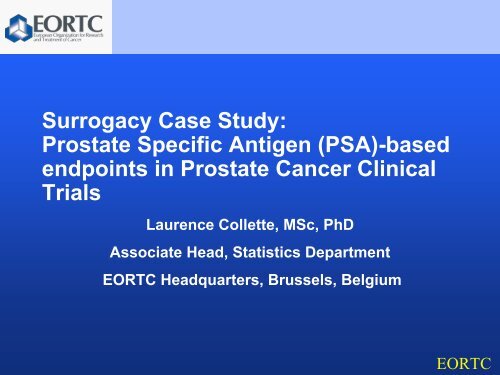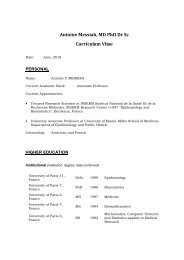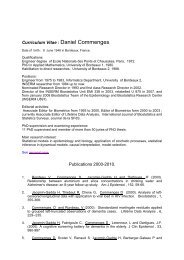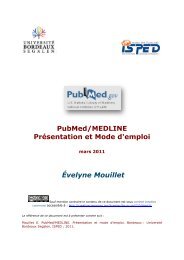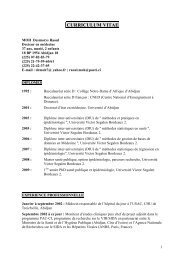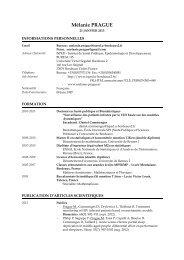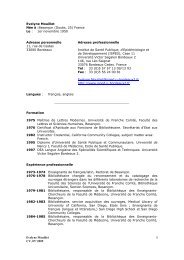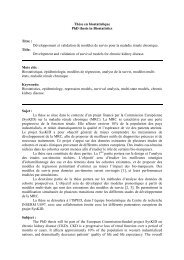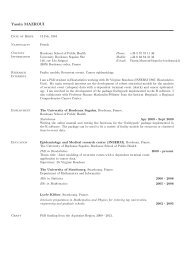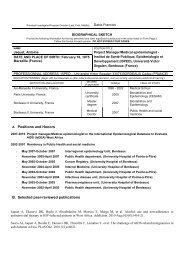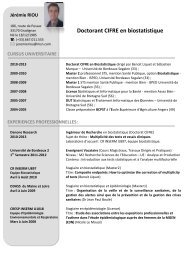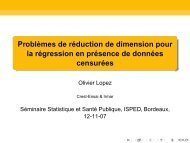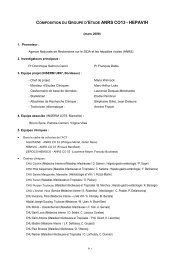Surrogacy Case Study: Prostate Specific Antigen (PSA ... - Isped
Surrogacy Case Study: Prostate Specific Antigen (PSA ... - Isped
Surrogacy Case Study: Prostate Specific Antigen (PSA ... - Isped
You also want an ePaper? Increase the reach of your titles
YUMPU automatically turns print PDFs into web optimized ePapers that Google loves.
EORTC<br />
<strong>Surrogacy</strong> <strong>Case</strong> <strong>Study</strong>:<br />
<strong>Prostate</strong> <strong>Specific</strong> <strong>Antigen</strong> (<strong>PSA</strong>)-based<br />
endpoints in <strong>Prostate</strong> Cancer Clinical<br />
Trials<br />
Laurence Collette, MSc, PhD<br />
Associate Head, Statistics Department<br />
EORTC Headquarters, Brussels, Belgium
<strong>Prostate</strong> cancer (PCa)<br />
• PCa is a cancer that affects older men (above 50, with<br />
peak incicence around age 70)<br />
• It is a very frequent disease: one in every 6 men will<br />
some day be diagnosed with prostate cancer (PCa)<br />
(Jemal et al. Cancer statistics 2003)<br />
• But it is a very slowly growing disease: PCa accounts<br />
for only 4% of all male deaths (SEER 1973-95)<br />
• PCa is an hormone sensitive disease, the mainstay of<br />
its treatment consists in androgen ablation.
<strong>Prostate</strong> <strong>Specific</strong> <strong>Antigen</strong> (<strong>PSA</strong>)<br />
• Most studied biomarker in cancer!<br />
• It is a glycoprotein that is produced (mostly) by the<br />
glandular tissue of the prostate and is normally secreted<br />
into semen or lost in urine<br />
• Normally, only very low levels are detectable in the<br />
blood<br />
• Elevated <strong>PSA</strong> levels are indicative of<br />
• presence of prostate cancer (detection), or<br />
• regarded as signs of disease activity after treatment<br />
(progression). <strong>PSA</strong> increases antedate clinical disease<br />
progression by several months to years.<br />
• <strong>PSA</strong> is also a prognostic factor and<br />
• Is used as indicator of response to treatment in some settings
<strong>Prostate</strong> <strong>Specific</strong> <strong>Antigen</strong> (<strong>PSA</strong>)<br />
• <strong>PSA</strong> is prostate-specific but not cancer specific.<br />
• <strong>PSA</strong> is androgen dependent.<br />
• Different therapies may have different effects on <strong>PSA</strong><br />
expression.<br />
• <strong>Prostate</strong> cancer is a heterogeneous disease: not all prostate<br />
cancer express <strong>PSA</strong> at the same level (eg: lower expression<br />
in poorly differentiated cancer)<br />
• Increases of <strong>PSA</strong> levels may be induced by<br />
• Prostatitis (infection)<br />
• BPH<br />
• Manipulations: prostate biopsy, TUR<br />
• Stones<br />
• Ejaculation<br />
• <strong>Specific</strong>ity is low!
Transition between clinical states of PCa<br />
<strong>Prostate</strong>ctomy Wait and See Hormones Chemotherapy<br />
Irradiation Hormones (Taxotere)<br />
Salvage RT<br />
Clinically<br />
Localized<br />
Disease<br />
Rising <strong>PSA</strong><br />
Clinical<br />
Metastases:<br />
Noncastrate<br />
Clinical<br />
Metastases:<br />
Castrate<br />
Death<br />
median<br />
8 years<br />
12-25% over 15 years<br />
Urology 55:323, 2000<br />
median<br />
3-5 years<br />
median<br />
1.5 years
Transition between clinical states of PCa<br />
Clinical endpoints take too long <br />
shorter endpoints are needed<br />
to fasten treatment development<br />
<strong>Prostate</strong>ctomy Wait and See Hormones Chemotherapy<br />
Irradiation Hormones (Taxotere)<br />
Salvage RT<br />
Clinically<br />
Localized<br />
Disease<br />
Rising <strong>PSA</strong><br />
Clinical<br />
Metastases:<br />
Noncastrate<br />
Clinical<br />
Metastases:<br />
Castrate<br />
Death<br />
median<br />
8 years<br />
12-25% over 15 years<br />
Urology 55:323, 2000<br />
median<br />
3-5 years<br />
median<br />
1.5 years
Surrogate endpoint<br />
• An outcome measure that is assessed earlier, more<br />
frequently or more easily than the final endpoint<br />
• That is “reasonably likely” to predict the eventual<br />
treatment benefit on the definitive endpoint<br />
(survival) (FDA definition)<br />
• Requires correlation between treatment effects on the<br />
marker and on the true endpoint, across groups of<br />
patients<br />
• <strong>Prostate</strong>-specific antigen (<strong>PSA</strong>)<br />
• <strong>PSA</strong> changes are indicators of disease evolution<br />
• 50% <strong>PSA</strong> decrease (“response”)<br />
• <strong>PSA</strong> increase (“progression”)
How to demonstrate surrogacy ?<br />
• Prentice Criteria: “A test of no treatment effect on<br />
the surrogate is equivalent to a test of no treatment<br />
effect on the true endpoint”<br />
• The treatment has a significant effect on survival<br />
• The treatment has a significant effect on <strong>PSA</strong><br />
• <strong>PSA</strong> is prognostic for survival<br />
• Once <strong>PSA</strong> is adjusted for, there is no significant treatment<br />
effect on survival<br />
• Meta-analytic validation: The treatment effect on the<br />
Surrogate is used to predict the treatment effect onto<br />
the True endpoint. A valid surrogate is one that<br />
enables a precise prediction.
Meta-analytic validation<br />
First stage: a joint model for<br />
individual observations on surrogate<br />
and true endpoints (Tij,Sij)<br />
Second stage: a linear model for the<br />
trial-specific trt effects ⎛αi<br />
⎞ ⎛α<br />
⎞ ⎛a<br />
i<br />
⎜<br />
⎟ = ⎜ ⎟ +<br />
⎜<br />
⎝ βi<br />
⎠ ⎝ β ⎠ ⎝b<br />
i<br />
⎟ ⎞<br />
⎠<br />
Trial-unit 1<br />
Trial-unit 2<br />
Trial-unit 3<br />
Trial-unit 4<br />
.<br />
.<br />
Trial-unit k<br />
(α <strong>PSA</strong><br />
, β OS<br />
)<br />
(α <strong>PSA</strong><br />
, β OS<br />
)<br />
(α <strong>PSA</strong><br />
, β OS<br />
)<br />
(α <strong>PSA</strong><br />
, β OS<br />
)<br />
.<br />
.<br />
(α <strong>PSA</strong><br />
, β OS<br />
)<br />
β OS<br />
R 2 trial<br />
close to 1<br />
Slope = R² trial<br />
α <strong>PSA</strong><br />
To allow precise prediction of the survival<br />
treatment effect from the <strong>PSA</strong> treatment<br />
effect<br />
Ref: Buyse et al, Biostatistics 2000; Burzykowski et al, Applied Statistics 2001
Validation Criteria<br />
R² trial =1: surrogate “perfect at the trial-level”<br />
R² trial ≈1: surrogate “valid at the trial-level”<br />
To be meaningful, a good surrogate must also<br />
demonstrate high correlation at the individual<br />
patient level (ie: be a strong prognostic factor)<br />
Ref: Buyse et al, Biostatistics 2000;1:49.<br />
• “how close” to 1 ?<br />
• Computationally intensive<br />
• Requires replicate trials of similar treatments
<strong>PSA</strong> – defined endpoints in prostate cancer<br />
• <strong>PSA</strong> endpoints<br />
• “Static” measures<br />
<strong>PSA</strong> response: 50% decline from baseline (confirmed by 2 nd<br />
observation)<br />
Time to biochemical relapse: time from entry to increase of the<br />
<strong>PSA</strong> above a certain thrshold (>0.2 ng/ml after RP, 2 increases<br />
after RT, increase by 50% confirmed (M1), increase back to<br />
50% of baseline..)<br />
• “Dynamic measures”<br />
<strong>PSA</strong> doubling time (<strong>PSA</strong>-DT) – exponential linear increase<br />
<strong>PSA</strong> velocity (<strong>PSA</strong>-V) – linear increase
<strong>PSA</strong> response and time to <strong>PSA</strong><br />
progression (different definitions)<br />
Baseline (B)<br />
Response:<br />
50% below B<br />
C: back<br />
to 50% of<br />
baseline<br />
Nadir (N)<br />
D> N+50%<br />
25<br />
B>N<br />
H. Scher JCO, 2004 (adapted)
<strong>PSA</strong> “surrogacy” studies in the<br />
literature<br />
• Many papers titled “<strong>PSA</strong> surrogate” in fact only<br />
demonstrate that <strong>PSA</strong> changes are prognostic for<br />
clinical relapse or death from the disease<br />
• Since 2000, only 12 publications truly dealing<br />
with <strong>PSA</strong> surrogacy
Published <strong>PSA</strong> surrogacy studies<br />
D’Amico<br />
JNCI ’03<br />
Dehnam<br />
Lancet ‘08<br />
Sandler<br />
JCO ’03<br />
Valicenti<br />
IJROBP ’06<br />
D’Amico<br />
J Urol ’05<br />
Newling<br />
JCO ’04<br />
After RP or RT<br />
(cohorts)<br />
After RT+0 or 3 or<br />
6 m ADT (TROG<br />
96.01)<br />
After RT+4 or 24 m<br />
ADT (RTOG 92-02)<br />
After RT+4 or 24 m<br />
ADT (RTOG 92-02)<br />
ADT for <strong>PSA</strong><br />
relapse after RP or<br />
RT (cohorts)<br />
M0 on primary<br />
ADT (EPC trial)<br />
<strong>PSA</strong>-DT PC-surv Prentice<br />
<strong>PSA</strong>-DT<br />
TTBF<br />
PC-surv<br />
Prentice<br />
TTBF PC-surv Prentice<br />
<strong>PSA</strong>-DT PC-surv Prentice<br />
<strong>PSA</strong>-V PC-surv Prentice<br />
T to <strong>PSA</strong><br />
doubling<br />
Clinical<br />
relapse<br />
Meta-analysis<br />
RP=radical prostatectomy, RT=radiotherapy, HT=hormonal therapy, M0=non metastatic,<br />
M1=metastatic, PC-surv=<strong>Prostate</strong> cancer specific survival
Published <strong>PSA</strong> surrogacy studies<br />
Collette<br />
JCO ’04<br />
M1 on ADT<br />
(Casodex CT’s)<br />
T to <strong>PSA</strong><br />
relapse<br />
Overall<br />
survival<br />
Metaanalysis<br />
Crawford<br />
(JCO ’04)<br />
HRPC on TXT<br />
(SWOG 99-16)<br />
<strong>PSA</strong><br />
response<br />
Overall<br />
survival<br />
Prentice<br />
Petrylak<br />
(JNCI ’06)<br />
HRPC on TXT<br />
(SWOG 99-16)<br />
<strong>PSA</strong>-DT<br />
Overall<br />
survival<br />
Prentice<br />
Roessner<br />
(ASCO ’04)<br />
HRPC on TXT<br />
(TAX-327)<br />
<strong>PSA</strong><br />
response<br />
Overall<br />
survival<br />
Prentice<br />
Armstrong<br />
(JCO ´07)<br />
HRPC on TXT<br />
(TAX-327)<br />
<strong>PSA</strong>-DT<br />
Overall<br />
survival<br />
Prentice<br />
Buyse<br />
(Springer ’03)<br />
HRPC on Liarozole<br />
or FLU/CPA<br />
<strong>PSA</strong><br />
response<br />
Overall<br />
survival<br />
Metaanalysis<br />
HRPC=hormone refractory prostate cancer, TXT=taxotere (chemotherapy),<br />
FLU=Flutamide (anti-androgen), CPA=cyproterone acetate (anti-androgen)
First remarks<br />
• Many of the papers (especially in the US) still rely<br />
on the Prentice Criteria for validation<br />
• Several papers are based on non randomized<br />
cohorts<br />
• Validity specific to<br />
• Disease stage<br />
• Form of summary statistic (eg: <strong>PSA</strong>-DT vs <strong>PSA</strong><br />
response for HRPC on Taxotere)<br />
• Treatment mechanism of action (HR vs Taxotere vs<br />
Other drugs)
Review<br />
• 2 meta-analytic validations in trials of long term<br />
ADT in M0 or M1 hormone sensitive<br />
• 2 Prentice validations in randomized trials of<br />
durations of ADT adjuvant to irradiation for<br />
locally advanced PCa<br />
• Trials in HRPC – chemotherapy vs cytostatic<br />
agents
<strong>PSA</strong> surrogate endpoint in M1<br />
prostate cancer?<br />
Bicalutamide (‘Casodex’)<br />
50 mg versus castration 1<br />
(n=530)<br />
Bicalutamide 100/150 mg<br />
versus castration 2,3<br />
(n=870)<br />
N=2161<br />
M1 (D2)<br />
WHO PS: 0-2<br />
Age: 71 years<br />
<strong>PSA</strong>: 200 ng/ml<br />
META<br />
ANALYTIC<br />
VALIDATION<br />
Bicalutamide 50 mg +<br />
castration versus<br />
flutamide + castration 4<br />
(n=761)<br />
Unit: by study and country<br />
1<br />
Iversen et al. Scand J Urol Nephrol 1996; 30: 93-98<br />
2<br />
Kaisary et al. Eur Urol 1995; 28: 215-222; 3 Tyrrell et al. Eur Urol 1998; 33: 447-456<br />
4<br />
Schellhammer et al. Urology 1995; 45: 745-752
<strong>PSA</strong> endpoints<br />
<strong>PSA</strong> normalization<br />
A <strong>PSA</strong> decline from baseline level (>20 ng/mL)<br />
to ≤ 4 ng/ml at 2 subsequent observations<br />
>4 weeks apart<br />
Time to <strong>PSA</strong> progression-1<br />
Time to <strong>PSA</strong> progression-2<br />
Time to a >20% increase above the nadir<br />
and which exceeded 4 ng/ml (UNL)<br />
Time to an increase >50% above the<br />
(3-)moving average nadir and which exceeded<br />
10 ng/ml (2.5xUNL). This increase had to be<br />
either the last observed value or be sustained for<br />
>4 weeks<br />
Longitudinal <strong>PSA</strong> profile<br />
The complete series of <strong>PSA</strong> measurements in<br />
each patient
Pooled results<br />
100%<br />
Time to <strong>PSA</strong> progression<br />
(50% increase)<br />
100%<br />
Overall survival<br />
75%<br />
50%<br />
HR=1.6<br />
75%<br />
50%<br />
HR=1.08<br />
25%<br />
Castration<br />
Casodex<br />
0%<br />
0 1 2 3 4<br />
Time (years)<br />
665/2094 (31.8%) progressed<br />
Median : 19 and 30 months (24.9)<br />
25%<br />
0%<br />
Castration<br />
Casodex<br />
0 1 2 3 4<br />
Time (years)<br />
1143 / 2161 (52.9%) died<br />
Median: 26 and 28 months<br />
5
<strong>PSA</strong> data (M1)<br />
Mean log(<strong>PSA</strong>)<br />
-2 0 2 4 6<br />
Association between <strong>PSA</strong> longitudinal<br />
changes and hazard of death<br />
R²(t) >= 0.90 at any time from m7<br />
0 12 24 36 48 60 72 84 96 108 120 132 144 156 168 180 192<br />
Week
Treatment effects on OS against treatment effects<br />
on Time to <strong>PSA</strong> Progression (20% rise)<br />
Effect on<br />
survival<br />
(log HR)<br />
1.0<br />
-0.5 0.0 0.5 1.0 1.5<br />
-1.0<br />
2.0<br />
-2.0<br />
-3.0<br />
-4.0<br />
R 2 trial<br />
= 0.21 (CI: 0 – 0.56)<br />
Low trial-unit correlation<br />
-5.0<br />
Effect on TTPP-1 (log HR)<br />
Within patient: concordance coefficient τ = 0.52 (SE=0.004)
Treatment effects on OS against treatment effects<br />
on Time to <strong>PSA</strong> Progression (50% rise)<br />
-0.5<br />
Effect on<br />
survival<br />
(log HR)<br />
-0.5<br />
0.0<br />
0.5<br />
1.0<br />
-0.5<br />
R 2 trial<br />
= 0.66 (CI: 0.3 – 0.85)<br />
Moderate trial-unit correlation<br />
Effect on TTPP-2 (log HR)<br />
Within patient: concordance coefficient τ = 0.61 (SE=0.02)
Treatment effects on <strong>Prostate</strong> Cancer Survival<br />
against treatment effects on Time to <strong>PSA</strong><br />
Progression (50% rise)<br />
1<br />
R 2 trial<br />
= 0.49 (CI: 0.16 – 0.82)<br />
Moderate trial-unit correlation<br />
0<br />
-1 -.5 0 .5 1<br />
-1<br />
Within patient: concordance coefficient τ = 0.64 (SE=0.02)
Prediction for a new trial – M1<br />
• R² trial for time to <strong>PSA</strong> progression (50% rise) is 0.66<br />
(95% CI:0.30 – 0.85)<br />
• Assuming a new study of 400 events leading to a HR<br />
for <strong>PSA</strong> of 0.50 (Z=-6.9, P=
<strong>PSA</strong> doubling-free survival (<strong>PSA</strong>-D) as a surrogate for<br />
progression-free survival in M0 hormone sensitive<br />
patients (EPC program)<br />
• EPC program: 3 randomized, double-blind, placebocontrolled<br />
trials of bicalutamide 150 mg/day vs placebo in<br />
addition to either RP, RTx or wawa<br />
• 8113 patients with T1b-4 M0 any N, from 23 countries<br />
• <strong>PSA</strong> doubling-free survival (<strong>PSA</strong>-D) = time to first of<br />
• a <strong>PSA</strong> doubling (value no lower than 0.2 ng/ml to a<br />
value of at least 0.4 ng/ml) or PFS event<br />
• Progression confirmed by bone scan, biopsy, CT scan<br />
or other imaging technique<br />
• Death of any cause<br />
Carroll K. et al, FDA, June ’04<br />
Newling, JCO ‘04
<strong>PSA</strong> doubling-free survival (<strong>PSA</strong>-D) as a surrogate<br />
for progression-free survival in M0 hormone<br />
sensitive patients (EPC program)<br />
1.0<br />
Log HR for PFS<br />
0.5<br />
0<br />
-0.5<br />
-1.0<br />
◦ = region<br />
-1.5<br />
-2.0<br />
-2.0 -1.5 -1.0 -0.5 0 0.5 1.0<br />
Log HR for <strong>PSA</strong>-D free survival<br />
R²=0.69, p=0.001<br />
Newling et al, ASCO 05
Recommendation, M0 and M1 hormone<br />
sensitive patients & hormonal treatments<br />
• <strong>PSA</strong> does not fully validate as a surrogate endpoint<br />
(R²
Recommendation, M1 hormone sensitive<br />
patients<br />
• Conversely, early marketing authorization might be<br />
sought on the basis of documentation very large effects<br />
on <strong>PSA</strong> progression (HR
4m vs 24m ADT adjuvant to irradiation of<br />
locally advanced PCa (RTOG 92-02)<br />
T2c-T4<br />
PreRx <strong>PSA</strong><br />
< 150 ng/ml<br />
R<br />
A<br />
N<br />
D<br />
O<br />
M<br />
I<br />
Z<br />
E<br />
Arm 1: goserelin and flutamide 2 mos<br />
before and during standard RT (STAD)<br />
1554 patients<br />
448 deaths<br />
145 of PC<br />
Arm 2: goserelin and flutamide 2 mos before<br />
and during standard RT, followed by goserelin<br />
alone for 24 mos (LTAD)<br />
Ref: Valicenti RK et al. Int J Rad Oncol Biol Phys 2006
4m vs 24m ADT adjuvant to irradiation of locally<br />
advanced PCa (RTOG 92-02)<br />
• Biochemical failure (ASTRO) failed the Prentice validation<br />
• LADT was superior to SADT for PC-survival (P=0.006) and<br />
for Biochemical failure (P
4m vs 24m ADT adjuvant to irradiation of<br />
locally advanced PCa (RTOG 92-02)<br />
• <strong>PSA</strong>-DT estimated based on minimum 3<br />
measurements (ASTRO definition of <strong>PSA</strong> failure)<br />
• Median follow-up 5.9 years<br />
• <strong>PSA</strong>-DT
<strong>PSA</strong>-DT and TTBF surrogate for PCa-specific<br />
survival after RT+ADT? TROG 96.01<br />
Locally<br />
advanced<br />
PCa<br />
R<br />
RT alone<br />
RT + 3 months ADT<br />
RT + 6 months ADT<br />
PC-<br />
Death<br />
• <strong>PSA</strong>DT ≤ 12 m and ≤ 15 m satisfied all Prentice<br />
criteria (PTE of 0.36 a 0.56 resp)<br />
• TTBF ≤ 1.5, 2 or 2.5 y satisfied all Prentice criteria<br />
(PTE between 0.45 & 0.64)<br />
?!??<br />
Ref: Denham JW et al. Lancet 2008
Explanation?<br />
• Time to testosterone recovery relates to duration of<br />
ADT and strongly influences the time to biochemical<br />
relapse<br />
<br />
Results obtained on trials with only short term ADT<br />
may not generalize to studies randomizing between<br />
longer durations of ADT<br />
Other comments (from Denham et al.):<br />
1. <strong>PSA</strong>DT strongly dependent on #<strong>PSA</strong> values available<br />
2. Cut-point on <strong>PSA</strong>-DT or TTBF not clearly defined<br />
3. Need a meta-analysis validation
<strong>PSA</strong> response or <strong>PSA</strong>-V<br />
surrogate for survival in HRPC?<br />
• Meta-analytic validation in 2 studies of liarozole versus<br />
CPA/FLU (1)<br />
• <strong>PSA</strong> response (50% decline) not a surrogate for OS<br />
• SWOG-9916: Docetaxel+Estramustine vs M+P (2)<br />
• <strong>PSA</strong> response (first 3 m) not a surrogate for OS<br />
• <strong>PSA</strong> velocity (first 3 m) is a surrogate for OS by Prentice<br />
criteria and should be further investigated<br />
• Tax 327: Docetaxel(D)(q1s)+Prednisone(P) vs D(q3s)+P vs<br />
Mitoxantrone(M)+P (3)<br />
• <strong>PSA</strong> response (50% decline from entry) not validated as<br />
surrogate for OS<br />
• Other changes in <strong>PSA</strong> or <strong>PSA</strong> kinetics are weaker<br />
surrogates<br />
1. Buyse M. et al In Biomarkers in Clinical Drug Development. Springer-Verlag, 2003<br />
2. Crawford et al. ASCO 2004, abs. 4505, Petrylak DP. J Natl Cancer Inst 2006.<br />
3. Roessner M et al. ASCO 2005, abs. 391s.; Armstrong AJ et al. JCO 2007
Ref.: Petrylak et al. JNCI 2006<br />
Of interest… in SWOG trial
Of interest…<br />
The search for the golden cut-point…<br />
Testing as much as 10…<br />
you’re certain to find something…
Tax 327 mimicking SWOG
Conclusions for HRPC on<br />
chemotherapy<br />
• Bubley et al (PCWG1, JCO ‘1995) proposed to use<br />
a 50% <strong>PSA</strong> decline as primary endpoints in phase<br />
II trials in HRPC Since then most phase II trials<br />
used it as primary endpoint in phase II and<br />
secondary endpoint in phase III trials<br />
• However, despite an apparent strong intraindividual<br />
correlation, <strong>PSA</strong>-response is NOT a<br />
surrogate in HRPC, even treated with Docetaxel.<br />
• <strong>PSA</strong>-V or <strong>PSA</strong>-DT may be better endpoints
ASCENT trial<br />
High dose Calcitriol (DN-101) + Docetaxel<br />
vs Placebo + Docetaxel<br />
• 250 men with M1 HRPC randomized to<br />
• Primary endpoint: <strong>PSA</strong> response (first 6 months<br />
defined as 50% decline)<br />
• Secondary endpoint: Overall survival, <strong>PSA</strong><br />
progression-free survival<br />
R<br />
Docetaxel + Placebo<br />
Docetaxel + DN-101<br />
Ref. Beer TM et al, JCO 2007
ASCENT trial<br />
High dose Calcitriol (DN-101) + Docetaxel<br />
vs Placebo + Docetaxel<br />
• Results:<br />
DN-101 Placebo P-value<br />
<strong>PSA</strong> response 58% 49% 0.16<br />
<strong>PSA</strong>-PFS 7.9 m 7.6 m 0.7<br />
Overall survival 24.5m 16.4 m P=0.04<br />
HR=0.67<br />
Ref. Beer TM et al, JCO 2007
Kaplan-Meier curve of overall survival in ASCENT trial<br />
Beer, T. M. et al. J Clin Oncol; 25:669-674 2007
Be aware of your drug’s effect on the marker<br />
Broken Arrow<br />
(Immuno, APC8501)<br />
No effect<br />
(anti-angiogenic drug as sorafeni<br />
Start of Therapy<br />
Lead In Post-therapy<br />
Delayed effect<br />
(Differentiating agent)<br />
Rapid decline<br />
(HT, CT, Suramin)<br />
Scher et al.
Proposed strategy for preparing the use of a marker<br />
in phase II<br />
• Solid preclinical and clinical data are needed about the<br />
drug’s effect on <strong>PSA</strong>, it’s shape, it’s timing (remember<br />
Calcitriol, APC 8501, Suramin..)<br />
• Neo-adjuvant studies are required to document<br />
• The effect of the new drug (alone or in the intended<br />
combination) on the marker<br />
• Correlation between changes in the marker and observed<br />
changes on the tumor<br />
• Without such information, even phase II trials with a markerbased<br />
endpoint, be it response or PFS, are a very risky<br />
gamble<br />
• New guidelines (PCWG2, JCO 08) move away from the <strong>PSA</strong><br />
response endpoint<br />
• Research is being done to make bone metastases changes<br />
measurable to use them as phase II endpoint


